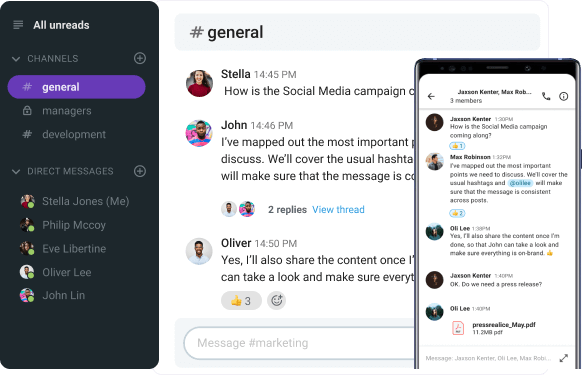Imagine this: it’s Monday morning, and your team is gearing up for a crucial project deadline. There’s a ton of emails, but the responses are slow, you can’t get everyone on the same page, and critical information is getting buried in your overflowing inbox. The clock is ticking, and frustration is mounting.
Now, picture this: your team uses an instant messaging app, and every message you send gets a rapid response. Your team is exchanging ideas, sharing files, and solving problems in real-time. Communication is seamless, the project progresses smoothly, and your stress levels remain steady.
This is the power that instant messaging can bring to your business.
Let’s see in more detail how instant messaging can benefit your business and a few pointers on how to use it effectively.

Table of Contents
What is instant messaging in business communication? How do businesses use instant messaging?
Instant messaging (IM) systems enable immediate communication between two parties, in written form. In simpler terms, instant messaging allows two or more people to chat with each other in real-time.
In addition, IM apps such as Pumble provide:
- File and link sharing,
- Voice and video calls,
- Notification preferences,
- Mentions and message formatting.
With these features, IM tools can serve as an efficient and centralized means of communication for your business.
Here are some examples of how businesses might use instant messaging:
- Team members working on the same project can use direct messages in an IM system to communicate on a daily basis.
- The members of the HR team can use polls in an internal IM tool to assess employee opinions and attitudes.
- A retail company can use their website to sell products, using an IM system to provide customer support.
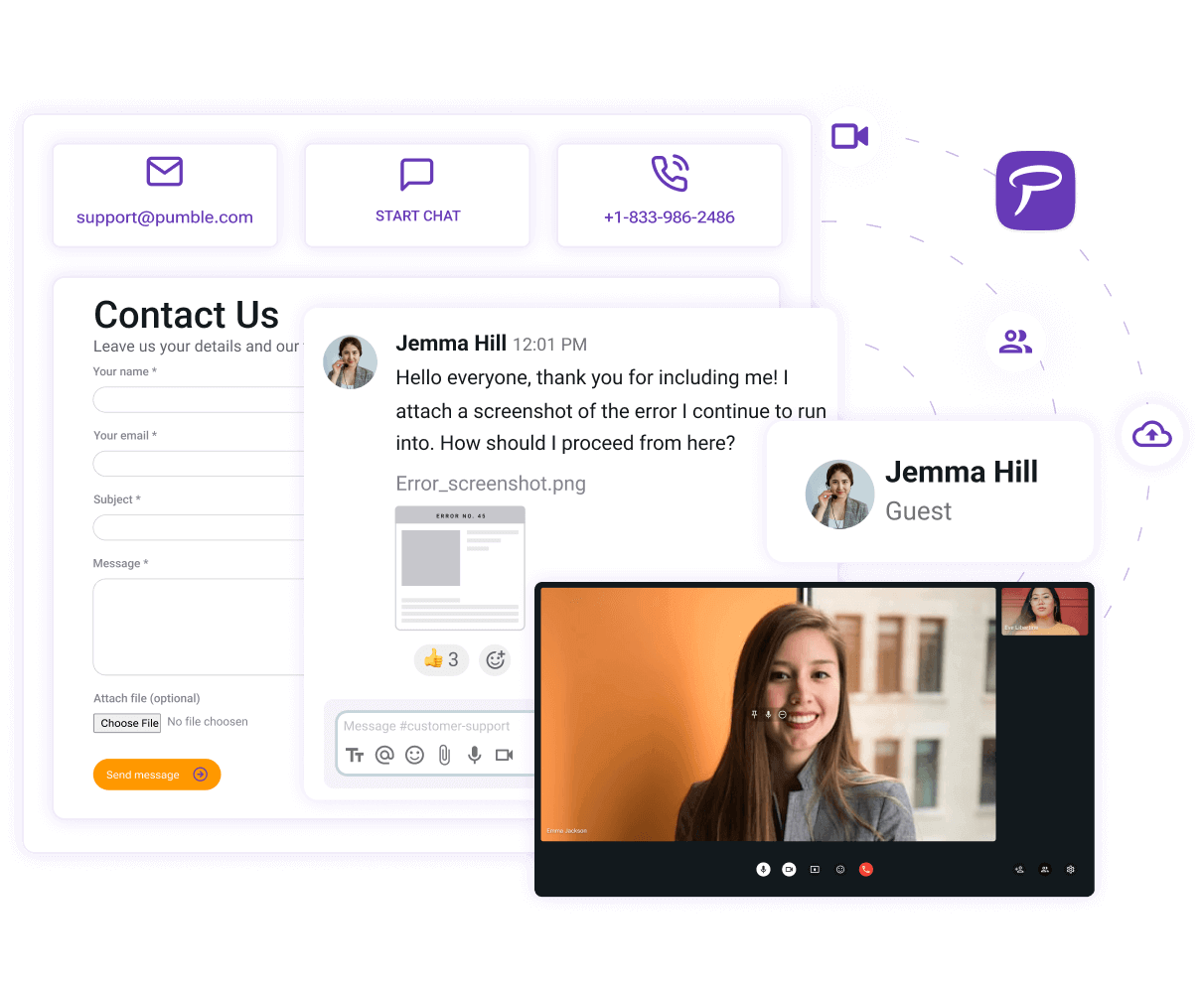
💡 Pumble Pro Tip
To see how your business can benefit from using Pumble, an instant messaging app, check out more use cases here:
What are the benefits of instant messaging?
In business communication, instant messaging is used for many different purposes and operations, grouped into two major categories: internal and external communication.
Instant messaging has specific benefits for each of these categories, as well as general benefits that apply to both of them.
Let’s explore all the benefits of instant messaging in the workplace.
The benefits of instant messaging for internal communication
The most notable benefits for businesses that use instant messaging for internal communication include features such as:
- Direct messages — This feature provides users with the ability to directly message another user, providing ease of access and information exchange.
- Group chat — IM tools also allow several users to communicate with each other at the same time, making collaboration a breeze.
- Sharing files — Instant file sharing is crucial for a productive day at work and for a culture that promotes knowledge sharing.
- Channels — Channels are spaces dedicated to specific teams, topics or projects, where you can chat with your team and work together towards a common goal, without overloading unrelated colleagues with messages irrelevant to them.
- Threaded conversations — Threads enable team members to answer specific questions without cluttering groups or channels with more messages.
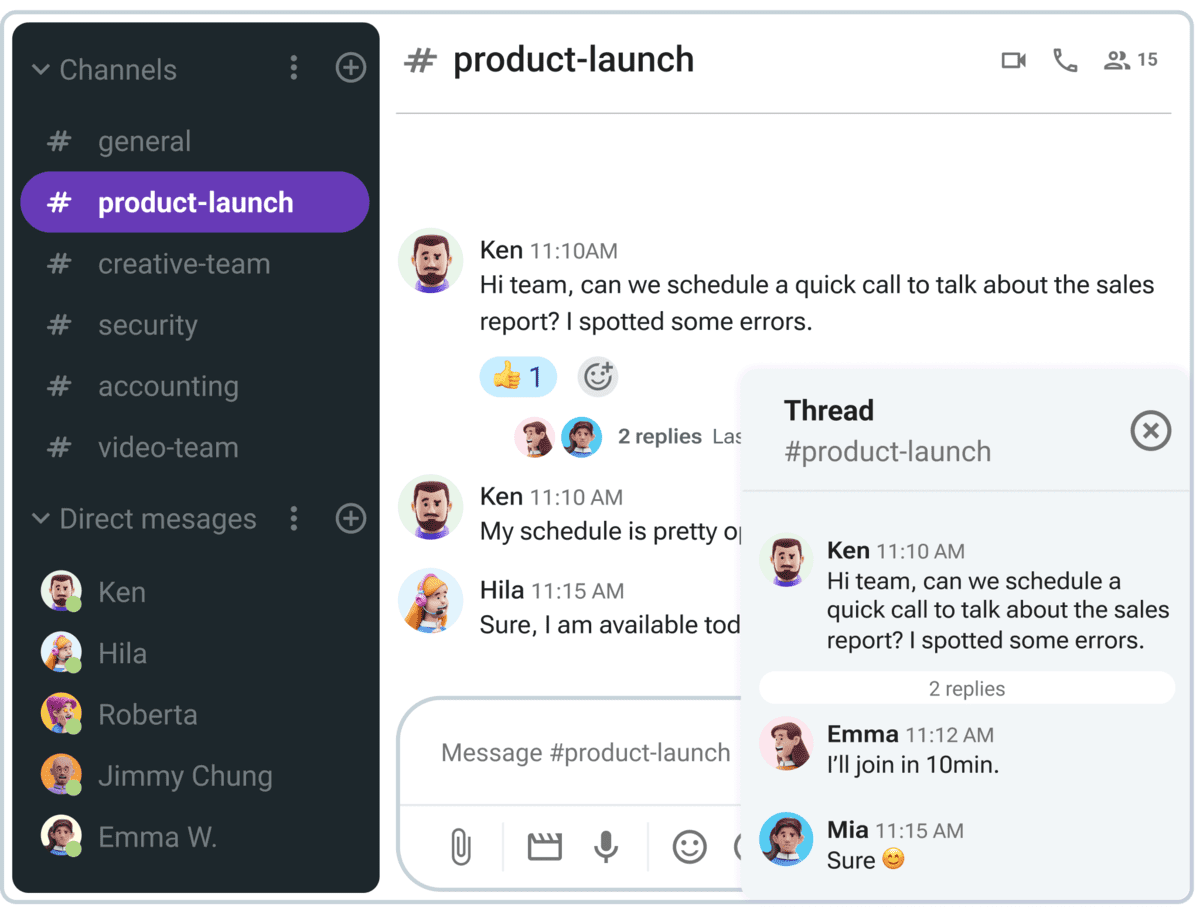
The benefits of instant messaging for external communication
Instant messaging for external communication purposes can be used, among other things, for:
- Customer support — IM is commonly used for customer support — it’s fast, reliable, and most people prefer chatting over phone calls.
- Sales — Sales are also more efficient with the use of IM — teams that use IM platforms report easier and faster collaboration, as well as more transparent and efficient communication.
- Communication with contractors and freelancers — An IM tool with a guest access feature lets people work with collaborators from outside of their organization.
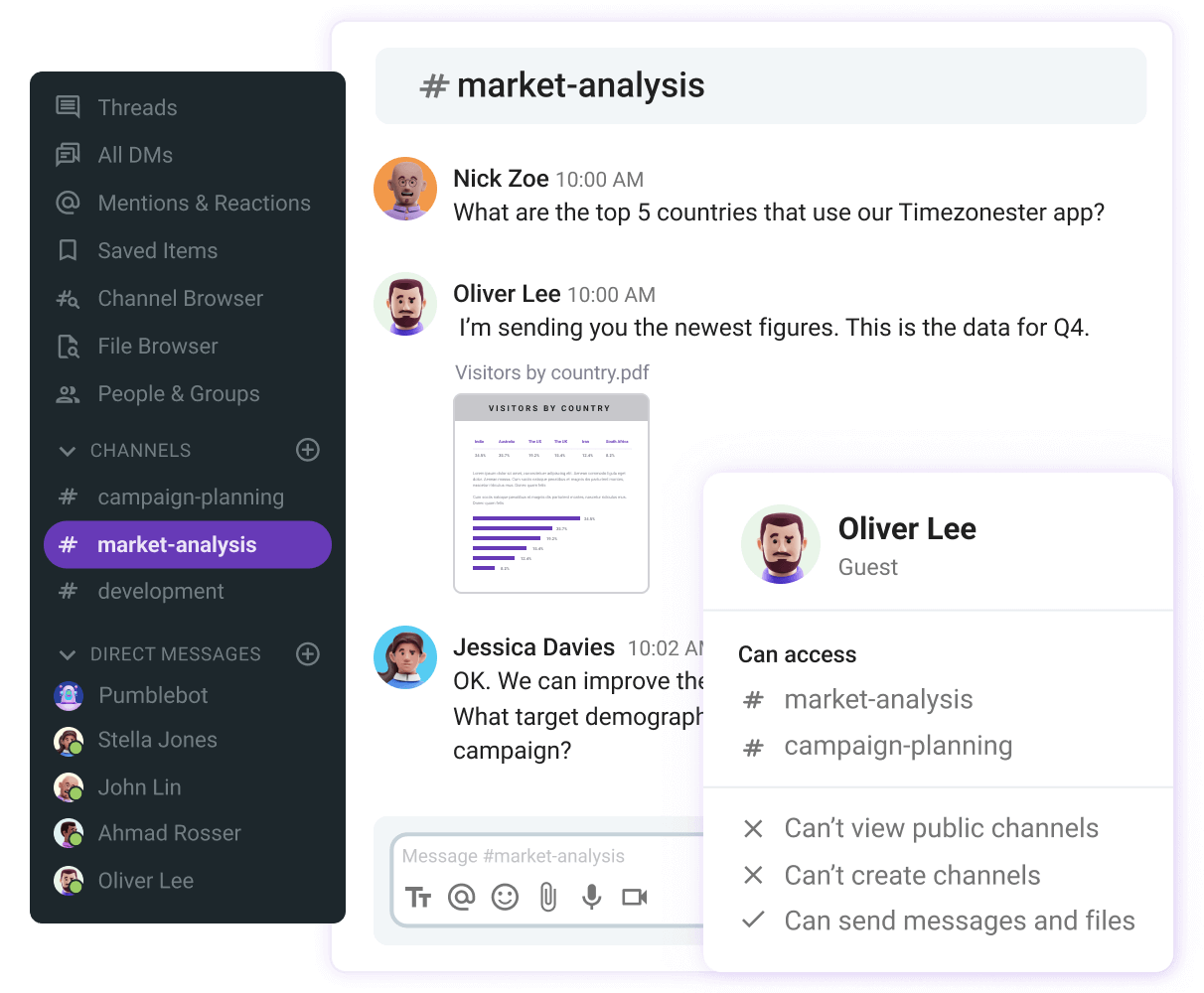
The general benefits of instant messaging for business communication
One of the primary benefits of IM is that it facilitates real-time communication, providing immediate updates and feedback.
This reduces miscommunication and ensures everyone is on the same page. The interactive nature of IM improves communication quality by allowing users to exchange messages, files, and other information in a way that mimics face-to-face interactions.
Moreover, IM builds trust among remote teams, which is crucial for effective group work. It promotes social relationships, facilitating smoother knowledge sharing among team members. The instantaneous nature of IM helps overcome psychological barriers to knowledge sharing, making employees more efficient and effective.
IM also serves as a valuable source of information for new employees. Access to older chat logs allows new hires to understand company dynamics quickly, facilitating smoother onboarding into the team. Additionally, you can use pinned messages in channels to highlight important information and key updates, ensuring that new employees can easily find essential resources.
Also, to get the benefits of older chat logs, it’s important to choose an IM app with unlimited message history, so that your team can refer to the comprehensive archive of past messages at any time.
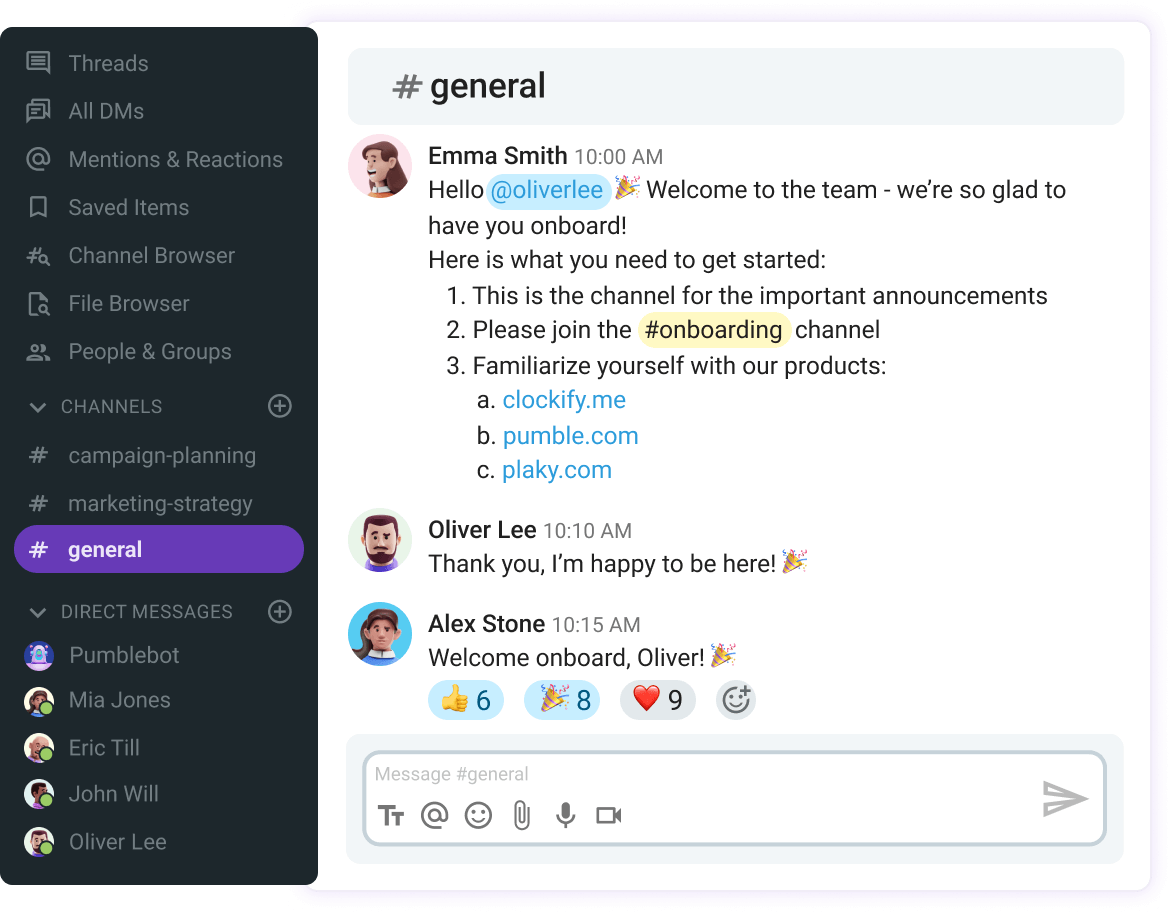
Additionaly, the use of emojis in IM exchanges enhances communication quality by conveying emotions and reducing misinterpretation.
Finally, one IM tool can replace many traditional communication tools like email and phone calls, centralizing all daily communication needs into one platform. It is also accessible on various devices, ensuring continuous connectivity and convenience for users who need to stay updated while on the go.
💡 Pumble Pro Tip
Instant messaging can be a valuable replacement for those in-office chats when you’re working remotely. To find out what else you can do to replace in-person conversations when working remotely, check out our blog post:
How to improve the effectiveness of IM in your business
If the benefits listed above sounded good enough for you to decide to implement IM in your business, here is how to do this effectively.
To make the most of IM in your business communication, you need to:
- Choose the right tool — Select IM tools that meet your company’s needs.
- Provide guidelines — Establish clear guidelines for IM use to prevent miscommunication.
- Minimize distractions — Use features like muting notifications to stay focused.
- Share only relevant information — Share information efficiently without overloading employees.
💡 Pumble Pro Tip
For more tips on how to foster effective communication, especially if your team is growing, check out our blog post:
Pumble: Your new instant messaging tool
Instant messaging can undeniably benefit your business.
By building trust and providing space for interactive communication, IM improves the social relationships at work. This effect cascades into increased employee productivity and satisfaction, who can use the many helpful features of IM tools to communicate without a hitch.
So, to get the best of what instant messaging has to offer, try Pumble — an all-in-one business communication app, designed to simplify your communication and connect your team.
Pumble offers a range of features, including:
- Channels,
- Threaded discussions,
- Seamless video and audio calls, and
- Unlimited message history.
So, try Pumble today and experience the difference that instant communication can make in your team!
And, to further enhance your team’s productivity, check out CAKE.com’s productivity bundle!

